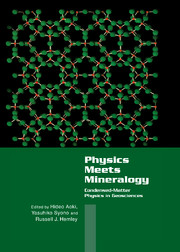Book contents
- Frontmatter
- Contents
- Preface
- List of Contributors
- Part I Introduction
- Part II Advances in Theoretical and Experimental Techniques
- Part III New Findings in Oxides and Silicates
- Part IV Transformations in Silica
- Chapter 4.1 Polymorphism in Crystalline and Amorphous Silica at High Pressures
- Chapter 4.2 Shock-Induced Phase Transitions of Rutile Structures Studied by the Molecular-Dynamics Calculation
- Chapter 4.3 Lattice Instabilities Examined by X-ray Diffractometery and Molecular Dynamics
- Chapter 4.4 Effect of Hydrostaticity on the Phase Transformations of Cristobalite
- Part V Novel Structures and Materials
- Part VI Melts and Crystal–Melt Interactions
- Subject Index
- Materials Formula Index
- Index of Contributors
Chapter 4.2 - Shock-Induced Phase Transitions of Rutile Structures Studied by the Molecular-Dynamics Calculation
Published online by Cambridge University Press: 05 November 2011
- Frontmatter
- Contents
- Preface
- List of Contributors
- Part I Introduction
- Part II Advances in Theoretical and Experimental Techniques
- Part III New Findings in Oxides and Silicates
- Part IV Transformations in Silica
- Chapter 4.1 Polymorphism in Crystalline and Amorphous Silica at High Pressures
- Chapter 4.2 Shock-Induced Phase Transitions of Rutile Structures Studied by the Molecular-Dynamics Calculation
- Chapter 4.3 Lattice Instabilities Examined by X-ray Diffractometery and Molecular Dynamics
- Chapter 4.4 Effect of Hydrostaticity on the Phase Transformations of Cristobalite
- Part V Novel Structures and Materials
- Part VI Melts and Crystal–Melt Interactions
- Subject Index
- Materials Formula Index
- Index of Contributors
Summary
To understand the anisotropic nature of the shock-induced phase transition of TiO2 (rutile), the transition to postrutile phases under isotropic and several stress-field conditions was studied by molecular-dynamics calculations. The rutile structure was shown to transform to the fluorite structure by a displacive mechanism under the isotropic compression within the time scale of the shock transition. Calculations with variable stress fields showed anisotropic behavior. The rutile–fluorite transition occurred smoothly with [100] compression of rutile. In the case of the [110] compression, the rutile structure transformed to a twinned fluorite structure. However, the rutile structure transformed to the CaCl2-type structure instead of the fluorite structure under the [001] compression. These results were in good agreement with actual shock experiments.
Introduction
Shock Compression Method for Solids
The dynamic compression method using shock wave has been utilized for highpressure research on solids. The method can easily generate high pressures to more than 100 GPa. In principle, the nature of the dynamic compression is understood by hydrodynamical considerations [1]: When a shock wave travels in solids with a supersonic speed (U) and accelerates particles to a particle velocity (w), the shock front is generated as a discontinuity boundary of pressure and density. In real solids, the discontinuity is observed as a very steep change of pressure in solids and the transition interval is only several nanoseconds.
- Type
- Chapter
- Information
- Physics Meets MineralogyCondensed Matter Physics in the Geosciences, pp. 205 - 224Publisher: Cambridge University PressPrint publication year: 2000



